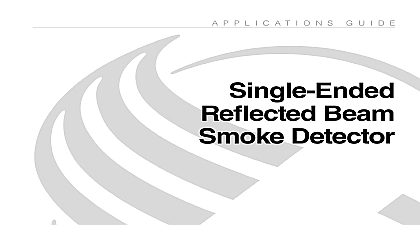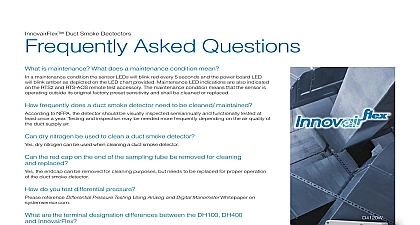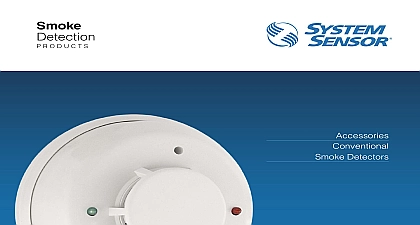System Sensor Duct Smoke Detectors

File Preview
Click below to download for free
Click below to download for free
File Data
| Name | system-sensor-duct-smoke-detectors-8247619035.pdf |
|---|---|
| Type | |
| Size | 1.42 MB |
| Downloads |
Text Preview
A P P L I C A T I O N S G U I D E Smoke Smoke 1 2 2 of Smoke in HVAC Systems 3 3 Smoke Detection Equipment 4 4 Air Handling Systems 5 5 Duct Detection Systems are Used to Control Smoke 6 6 for Duct Smoke Detector Application and Installation 7 7 and Service of Detectors for Use in Ducts 10 8 of Terms 12 purpose of this guide is to provide much needed information concerning the proper use of smoke detectors in duct applications Duct mounted detectors are designed to provide a specific type of protection that cannot be duplicated by any other type of system However there has been tendency to misapply these devices in the past by attempting to use them as a substitute for an early warning smoke detection system This fact cou with new methods of detecting smoke in ducts has prompted the writing of this industry guide Fire protection engineers mechanical and electrical fire alarm system designers and installers should find the contents both educational and informative information is intended as a technical guide as distinct from mandatory requirements GUIDE DUCT SMOKE DETECTORSfirealarmresources com 1 of Duct Smoke Detection and local safety standards and codes recognize the ability of air systems to transfer smoke toxic gases and flame from area to area smoke can be of such quantity as to be a serious hazard to life unless blowers are shut down and dampers are actuated The pri purpose of duct smoke detection is to prevent injury panic and damage by reducing the spread recirculation of smoke Duct detection also can serve to protect the air conditioning system itself fire and smoke damage and can be used to assist in equipment pro applications for example in the ventilation exhaust duct work of computers and tape drives more important is the identification of what duct smoke detection not intended for rather than what it is It is not a substitute for an area smoke detector It is not a substitute for early warning detection It is not a replacement for a building regular fire detection system 90A 2012 A 6.4 supports this by stating provided by installation of smoke detectors and other related requirements is intended prevent the distribution of smoke through the supply air duct system and to exhaust a significant quantity of smoke to the outside Neither however will guarantee either early detection of fire or the detec of smoke concentrations prior to dangerous smoke conditions if smoke is other than through the supply air system 72 2013 17.7.4.3 and section 907.3.1 of the 2015 edition of the Fire Code states that are installed in the air duct shall not be used as a substitute for open air protection smoke detectors are the preferred means of controlling smoke spread Duct smoke detectors can only detect smoke when smoke laden air is in the ductwork Fans may not be running at all times such during cyclical operation or during temporary power failure Duct smoke detectors sample great volumes of air from large areas of They cannot be expected to match the detection ability of detectors Dirt contaminated air filters can restrict air flow causing a reduction in operating effectiveness of the duct smoke detectors 90A2 for the Installation of Air Conditioning and Ventilating specifies that detectors listed for use in air distribution shall be located as follows Downstream of the air filters and ahead of any branch connections in air systems having a capacity greater than 2,000 cfm 944L sec At each story prior to the connection to a common return and prior to recirculation or fresh air inlet connection in air return systems hav NFPA 90A 2013 Appendix A 6.4 2 NFPA 90A 2012 Section 6.4.2.1 a capacity greater than 15,000 cfm 7080 L sec and serving more one story system smoke detectors are not required when the entire space by the air distribution system is protected by a system of area smoke NFPA 90A 2012 6.4.2.2 units whose sole function is to remove air from inside the building to the building NFPA 90A 2012 6.4.2.3 Documents International Mechanical Code IMC specifies that the space is air and the A C unit is over 2,000 CFM a duct smoke detector is to be installed in the return air duct IMC 2012 606.2.1 Smoke detectors are not required in the return air system all portions of the building served by the air distribution system are by area smoke detectors connected to a fire alalrm system in with the International Fire Code The area smoke detector shall with Section 606.4 are several important documents that provide guidance concern the performance application and installation of duct smoke detectors U L Standard 268A Standard for Smoke Detectors for Duct Applications NFPA Standard 90A Installation of Air Conditioning and Ventilating Differences Large Spaces NFPA 92A Standard for Smoke Control Systems Utilizing Barriers and NFPA 92B Standard for Smoke Management Systems in Malls Atria NFPA Standard 72 National Fire Alarm Code NFPA Standard 101 Life Safety Code ASHRAE Handbook and Product Directory and Smoke Control International Mechanical Code Scenarios smoke detection may be useful in preventing injury and property dam in instances such as the following heating ventilating or air conditioning HVAC fan motor overheats and smoke is sensed by the duct smoke detector installed in the main duct The duct smoke detector is equipped with an auxiliary relay immediately cuts power to the fan motor before significant amounts of can be distributed to the occupied areas the primary purpose for detecting smoke in the HVAC system is to initiate action to minimize the spread of smoke through the handling system it follows that the nature of the smoke to be expected various parts of the system should be understood The following discus is a theoretical description of smoke characteristics as they pertain to application as yet not supported by fire test data SENSORfirealarmresources com 2 of Smoke in HVAC Systems detectors are designed to sense the presence of particles of com but depending on the sensing technology and other design factors detectors respond to different types of particles Detectors based ionization detection technology are most responsive to smaller invisible sized particles Detectors based on light scattering technology contrast are most responsive to the larger visible particles Detectors on light extinction technology respond to both visible and invisible Figure 1 shows the relative sensitivity of the three technologies a function of particle diameter assuming a constant mass of particles is generally accepted that particle size distribution varies from sub micron particles predominant in the proximity of the flame of a flaming to particles one or more orders of magnitude larger characteristic of from a smoldering fire The actual particle size distribution depends a host of other variables including the fuel and its physical makeup availability of oxygen including air supply and fire gas discharge and ambient conditions especially humidity Moreover the particle size is not constant as the fire gases cool the sub micron particles and the very large ones precipitate In other words as smoke away from the fire source the particle size distribution shows a rela decrease in smaller particles Water vapor which is abundantly present most fires when cooled sufficiently will condense to form fog particles effect frequently seen above tall chimneys Since water condensation basically clear in color when mixed with other smoke particles it can be to change the color of the mixture to a lighter one


